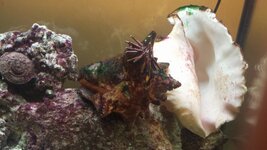Here's what I did, but it is just what worked for me. I had an extra sink in my laundry room, so I bought a reverse osmosis/de-ionization system off ebay ($120-$150). I used rubbermaid totes and 5 gallon buckets for water changes. I always pre-made water in case of emergency (and it WILL happen). I figured out how much 10 and 20 gallons was and drew a line with sharpie on the outside of the tote.
I did water changes with 5 gallon buckets and then carried and dumped the bucket. I'm not sure how 20 feet of hose would work to siphon water... it is downhill from the tank?
Just me, but I never added chemicals to the water, always figured it was better to filter out toxins/impurities instead of try to mask/deactivate them.
I did water changes with 5 gallon buckets and then carried and dumped the bucket. I'm not sure how 20 feet of hose would work to siphon water... it is downhill from the tank?
Just me, but I never added chemicals to the water, always figured it was better to filter out toxins/impurities instead of try to mask/deactivate them.


 we ordered an octopus from the LFS.
we ordered an octopus from the LFS.